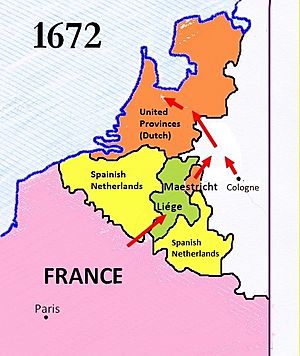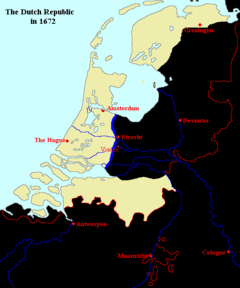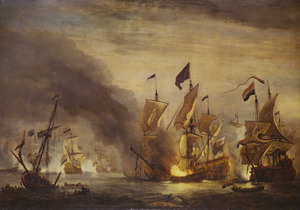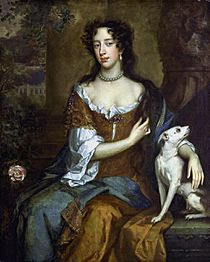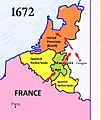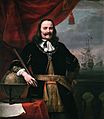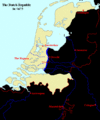Third Anglo-Dutch War facts for kids
Quick facts for kids Third Anglo-Dutch War |
|||||||
|---|---|---|---|---|---|---|---|
| Part of the Anglo-Dutch Wars and Franco-Dutch War | |||||||
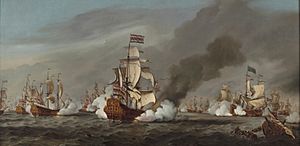 The Battle of Texel, by Van de Velde the Younger |
|||||||
|
|||||||
| Belligerents | |||||||
| Commanders and leaders | |||||||
The Third Anglo-Dutch War was a naval conflict between the Dutch Republic and England. It took place from March 27, 1672, to February 19, 1674. England was allied with France in this war. This conflict was part of a larger war called the Franco-Dutch War, which lasted from 1672 to 1678.
In 1670, King Charles II of England secretly agreed to help King Louis XIV of France attack the Dutch Republic. This agreement was known as the Secret Treaty of Dover. Louis XIV hoped to take control of the Spanish Netherlands. Charles II wanted to improve his reputation after a embarrassing attack by the Dutch in 1667, known as the Raid on the Medway. Charles also received secret payments from France, hoping to become financially independent from the English Parliament.
In May and June 1672, the French army quickly took over most of the Dutch Republic. They were stopped only by water defenses in the main province of Holland. In early June, the Dutch navy, led by Michiel de Ruyter, badly damaged the combined English and French fleet at the Battle of Solebay. This victory helped the Dutch keep control of important trade routes. Later in June, Johan de Witt, a key Dutch leader, resigned. Charles' nephew, William III of Orange, became the new leader, called the Stadtholder.
Charles tried to convince William to make peace, but William refused. He knew that the alliance between England and France was not popular in England. Also, other European countries like the Holy Roman Empire and Spain supported the Dutch because they feared France's growing power. By the end of 1672, the Dutch had won back much of the land they lost. The English Parliament refused to give Charles more money for the war, as most members were against it. From June to July 1673, the Dutch and Anglo-French fleets fought three more battles. These battles did not have a clear winner, but they ended any chance of France conquering the Dutch Republic. Louis XIV then focused on taking the Spanish Netherlands, which was also bad for England's interests. Because of strong opposition at home, Charles II had to agree to the Second Peace of Westminster in February 1674, ending the war.
Contents
Why the War Started: Background Events

The first war between England and the Dutch, from 1652 to 1654, happened because of business competition. It also involved supporters of the exiled King Charles II of England. In 1654, a peace treaty was signed. It included a rule that the House of Orange-Nassau, William III's family, could not hold public office. This kept the Dutch Republic under political control of its leaders.
When Charles II became King of England again in 1660, his ties to the House of Orange meant that Dutch leader Johan de Witt did not want an alliance with England. After these talks failed, De Witt made a treaty with King Louis XIV of France in 1662.
Even though France had supported the Dutch in their war against Spain for many years, France's goals in the Low Countries (like Belgium and the Netherlands) worried the Dutch. The 1648 peace treaty had closed the Scheldt river mouth. This helped Amsterdam by removing its rival city, Antwerp. Keeping the Scheldt closed was very important for the Dutch. Changes in this area also worried England, because control of ports on the coast of Flanders could allow an enemy to block the English Channel.
In 1665, an attack by the Duke of York on a Dutch trading company led to the Second Anglo-Dutch War. The Dutch suffered a major naval defeat and an invasion by Münster, a German state. The chance of an English victory made Louis XIV activate his 1662 treaty with the Dutch. However, the Dutch felt France's support was not enough. When the Dutch leaders refused Louis's requests for land, he started the War of Devolution in May 1667. He quickly took over much of the Spanish Netherlands.
Charles II could not get money from Parliament, so he had to pay off his navy in early 1667. This led to the embarrassing Raid on the Medway by the Dutch. Despite this Dutch victory, the Dutch were more worried about France's gains. They quickly ended the war in July 1667 and began talks with England about how to stop France. Charles saw an opportunity and offered an alliance to Louis, but Louis did not want to pay the money Charles demanded. However, De Witt welcomed English representatives, hoping to put pressure on France.
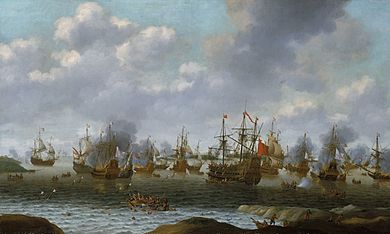
French taxes on imports in early 1667 increased opposition in the Dutch government. They preferred a weak Spain as a neighbor rather than a strong France. On January 23, 1668, the Dutch Republic, England, and Sweden signed the Triple Alliance. They promised to help each other if France or Spain attacked one of them. Charles II told Louis XIV about a secret part of the agreement to help Spain if France continued the war. Louis felt betrayed by the Dutch. Louis returned most of the lands he had taken in the 1668 peace treaty, but he kept some cities.
Louis decided that the best way to achieve his goals in the Spanish Netherlands was to defeat the Dutch Republic. This meant breaking up the Triple Alliance. Since the Dutch had not paid Sweden the money they promised, it was easy to get Sweden to leave the alliance by offering them money. England was Louis's next target. The French and English kings secretly negotiated the 1670 Secret Treaty of Dover. Charles's sister, Henrietta of England, helped with the talks. Very few English leaders knew about the treaty's details.
The treaty included a military alliance between England and France against the Dutch Republic. It also planned for a small Dutch state for Charles's nephew, William. England would also provide soldiers for the French army. The treaty was signed in December 1670. Secret parts of the treaty, not revealed until 1677, showed that Louis agreed to pay Charles a large amount of money each year. He also promised money for the English navy and for Charles to publicly become Catholic. Charles also demanded control of Dutch sea routes.
After 1667, tensions between England and the Dutch lessened. There was little support in England for an alliance with France against the Dutch. England giving up the Dutch colony of New Amsterdam for a spice island solved a big disagreement. Both countries were worried about France's goals in the Low Countries. English merchants were also affected by French taxes. Most Dutch and English politicians saw the Triple Alliance as important protection against France. In early 1671, Parliament gave money to the Royal Navy to fulfill its duties under the treaty.
Getting Ready for War
Louis XIV told his ambassador in The Hague to continue talks with the Dutch leader De Witt. This was a trick to gain time while he finished his invasion plans. The English ambassador was given the same mission by Charles II. Dutch defenses were mostly along their southern border with the Spanish Netherlands. So, Louis made an alliance with Cologne, a German state. This allowed his army to march through another German state for an attack from the east. This also kept his promise to the Holy Roman Emperor not to use the Spanish Netherlands as an invasion route.
In April 1672, France agreed to pay Sweden to stay neutral. France also promised military help if Sweden was "threatened" by Brandenburg-Prussia. This canceled out an agreement between the Dutch and Frederick William, whose lands were on their eastern border. Hoping for English support, the Dutch government appointed Charles's 22-year-old nephew William as the general of the Dutch army in February 1672. The army was supposed to have 83,000 men. But because French plans were unclear, most of these troops were in the wrong places. Many garrisons were also under strength.
The Dutch Republic was better prepared for a naval war. However, to avoid angering the English, the Dutch government reduced the navy's budget in February. At the end of the Second Anglo-Dutch War in 1667, the Dutch Navy was the largest in Europe. But by 1672, the combined English and French fleet was much larger. However, the French navy was new and inexperienced. Their ships were not well designed, and there was a lot of distrust between them and the English navy.
In earlier battles, the Dutch had struggled with their new, heavier warships. Their complex command system and conflicts between admirals also caused problems. By 1672, these issues were fixed. Admiral De Ruyter trained his fleet intensely in "line-of-battle" maneuvers. This brought a new sense of order and discipline. Dutch ships were generally better for firing cannons. Their shallow design was good for operations near the coast, but they were slow in open seas. Even though some Dutch ships were kept back for defense, better training and design made them equal in battle.
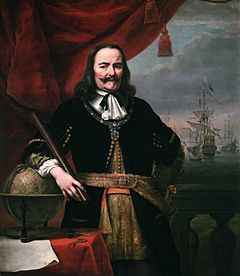
England provided two-thirds of the combined English-French fleet of 98 large ships. Their goal was to control Dutch waters, land troops, and attack Dutch shipping. Parliament usually approved money for the navy, as it protected English trade. But they refused to fund land forces. The British soldiers for the French army were mostly mercenaries who had served France since 1631. Very few of them saw action before the war ended.
Parliament refused to approve taxes for a war against the Protestant Dutch, especially in alliance with Catholic France. This forced Charles II to find other ways to get money. In January 1672, he stopped repaying government debts. This raised a lot of money but caused huge economic problems. Many London merchants went bankrupt, and it stopped short-term loans needed for international trade. In late March, two weeks before declaring war, Charles ordered an attack on a Dutch merchant convoy in the Channel. The Dutch escort ships fought them off.
The French alliance was unpopular, and Charles lacked money. So, he gambled on a quick war. To gain support from Protestants who were not part of the Church of England, he issued a Royal Declaration of Indulgence in March. But by also removing restrictions on Catholics, it did little to reduce opposition. Hostility grew when Charles appointed his Catholic brother James as the head of the navy, instead of his Protestant cousin. Even the Royal Navy struggled to find enough sailors to fully staff its ships.
Charles's chief minister was told to "break with (the Dutch), yet to lay the breach at their door." This was done using made-up incidents. One example was the Merlin affair in August 1671. A royal yacht was ordered to sail through the Dutch fleet. The Dutch ships saluted but did not fire white smoke, an honor given only to warships. A formal complaint to the Dutch government was dismissed. Few in England even knew about the incident. Using this as an excuse, along with the attack on the Dutch convoy, led some English politicians to call the war "unjust." England declared war on March 27, followed by France on April 6.
The War in 1672: A Year of Disaster
Overview of the Conflict
When the French invaded the Dutch Republic in May 1672, it seemed like a huge victory for them. By the end of June, only the Dutch Water Line stood between them and the main province of Holland. By opening floodgates, the Dutch managed to stop the French advance. The Dutch survived because they controlled the sea. This allowed them to bring in supplies and keep trade routes open. Even though they had fewer ships, Admiral De Ruyter attacked the combined English-French fleet at the Battle of Solebay on June 7. Both sides lost one ship, but this battle ended major naval operations for the year.
This unexpected success was a mixed blessing for Louis XIV. It distracted him from his main goal of capturing the Spanish Netherlands. The idea of France controlling the Dutch Republic, which was Europe's biggest trading power, brought the Dutch support from the Holy Roman Emperor and Spain. It also increased opposition in England, where many had been against the alliance with Catholic France from the start. Peace talks did not go well. An overconfident Louis made demands that even his English allies found unacceptable. The Dutch used this time to gain allies and rebuild their army. By the end of 1672, they had won back much of the land lost in May. Charles II had run out of money, and Parliament was unwilling to give him more.
French Successes and Dutch Struggles
The speed with which the Dutch Republic was taken over in 1672 led to it being called the Rampjaar or 'Year of Disaster'. On May 7, a French army of about 80,000 soldiers entered Liège. Louis XIV was with them. They went around the Dutch stronghold of Maastricht and crossed the Meuse river. They then attacked Dutch-held fortress towns along the Rhine river. The last of these surrendered on June 9. At the same time, troops from Münster and Cologne entered two Dutch provinces.
On June 12, the French crossed the Lower Rhine river. They went around the Dutch defenses and took Arnhem on June 16 and Zutphen on June 25. William and his troops were in danger of being cut off from the main province of Holland. They retreated behind the Holland Water Line. The floodgates were opened on June 22, stopping the French advance in this area. On July 5, one Dutch province surrendered to the Prince-Bishop of Münster, who then occupied another province. He reached Groningen, but flooding prevented a proper siege, and his troops soon ran out of food.
The Dutch government had reacted to the March attack on their convoy by increasing their active fleet. They also ordered the building of 36 new ships. Still, they were outnumbered by the combined English-French fleet. De Ruyter pulled back into shallow waters near the Dutch coast, waiting for a chance to attack. Disasters on land meant that the Dutch leader De Witt needed a victory. He ordered De Ruyter to attack.
When the Allied fleet went to Solebay, near Southwold, to resupply, De Ruyter surprised them on June 7 at the Battle of Solebay. The Duke of York led his ships against the main Dutch fleet. But his French colleague either misunderstood or ignored his orders, sailing in the opposite direction. The 30 French ships fought a separate, long-range battle with 15 Dutch ships. The French commander was later criticized by his own officers for not fighting more closely.
The Earl of Sandwich was killed when his ship, the Royal James, was sunk by fireships. Other ships were also badly damaged. Although both sides lost about the same number of ships, Solebay ensured the Dutch kept control of their coastal waters. It secured their trade routes and ended hopes of an English-French landing in Zeeland. Anger at the French for not providing enough support increased opposition to the war in England. Parliament was unwilling to approve money for necessary repairs. For the rest of the year, English naval operations were limited to a failed attack on a Dutch trading fleet.
However, this did not make up for the damage caused by Dutch defeats on land. It was impossible to hide how serious the crisis was. Many pamphlets accused the De Witt brothers and the government of betraying the country to the French. There were widespread riots. Supporters of William of Orange took control of city councils and demanded William take over the government. On June 22, Johan de Witt was badly hurt in an assassination attempt. One of the attackers was arrested and executed, which increased public anger against the De Witts.
Peace Talks and Political Changes
The Dutch were helped by the fact that France and England had different goals. Also, Louis XIV overestimated his strong position after his initial success. French expansion in the Spanish Netherlands was mainly meant to help their economy at the expense of the Dutch. But it also hurt English trade and security. If Louis also gained control of Holland, the financial and commercial center of Europe, the potential increase in French power threatened every other European country.
On June 14, the Dutch province of Holland began peace talks. They offered Louis the right to occupy key fortresses in the south and to pay him a large sum of money. Louis responded with more demands, including religious freedom for Catholics or French control over two Dutch provinces. Both sides were using the talks to buy time, hoping their position would improve. Louis knew the Dutch representatives could not agree to terms about religion or giving up parts of their provinces. The English were to be given a Dutch city that was already under attack.
People who supported William of Orange pushed for him to be appointed leader of Holland on July 4. They presented Charles II as the only person who could save them from the French. Hoping for a quick win, Charles sent two English leaders to meet William. They were joined by Dutch exiles who had fled after a failed attempt to take power in 1666. They arrived at William's headquarters on July 5. Crowds cheered them, believing they brought promises of English support. The mood quickly changed when their demands were made public. France and Münster were to keep their conquests. William would become the ruler of Holland. In return, he would pay England a large sum of money, yearly payments for fishing rights, and allow English soldiers to occupy three Dutch cities.
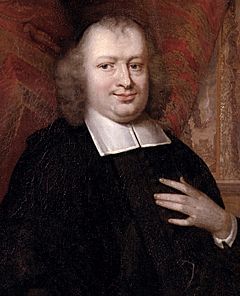
William rejected the offer because it gave the Dutch nothing they did not already have. The English leaders then met with Louis XIV and agreed to the Heeswijk Accord on July 16. This listed shared demands and promised not to make a separate peace. But neither side trusted it. The Holy Roman Emperor's representative in The Hague promised the Dutch government Imperial support. He also arranged for Spanish troops to hold two Dutch fortress cities, freeing up their soldiers for the main army.
A second letter from Charles II on July 18 urged William to accept his terms. Charles claimed the De Witt brothers were the only obstacle to peace. William responded by offering fishing rights, a large sum of money, and two cities, in return for being recognized as Prince of Holland and England agreeing to a separate peace. Based on the Heeswijk Accord, Louis demanded the Dutch give their naval base to England, a demand he knew was unacceptable. After the terms were rejected on July 20, the English leaders returned to London.
Johan de Witt had resigned as Grand Pensionary in June. His brother Cornelis was arrested for supposedly plotting to murder William. On August 15, Charles's letter blaming the De Witts was published in Holland. The reasons for this are still debated, but it made tensions worse. The two brothers were killed by a mob on August 20. Gaspar Fagel, a supporter of William of Orange, became Grand Pensionary. On August 27, the Dutch province of Holland passed laws that removed political opponents from local office. This secured William's political position.
Dutch Comeback: Second Half of 1672
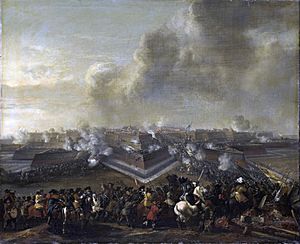
On July 7, the Dutch Water Line was fully flooded. Its effectiveness would be reduced when the waters froze in winter, but for now, Holland was safe from French advance. This gave the Dutch government time to make military changes approved on July 16. They were also boosted by the return of 20,000 prisoners ransomed from the French. In addition to unofficial Spanish support, the Holy Roman Emperor promised to invade German regions with 16,000 troops. Frederick William had also promised 20,000 troops in May.
This forced Louis XIV to send 40,000 men to meet this threat. Nearly 50,000 French soldiers were tied up in garrisons around the Dutch Republic. English hopes of a quick victory disappeared after the Battle of Solebay. The removal of the De Witts secured William's position and ended his reliance on Charles II. The Münster army fell apart due to lack of supplies. On August 27, the Prince-Bishop of Münster gave up the siege of Groningen. His army lost over 11,000 men, including 6,000 who deserted. Many of these deserters joined the Dutch.
William led attacks on two cities. These attacks were too ambitious and failed, but they helped restore Dutch morale. The city of Coevorden was recaptured on December 31. Although their situation was still difficult, by the end of 1672, the Dutch had won back much of the territory lost in May. Louis XIV found himself in a wider European war that would last a long time. Despite the money he received from France, Charles II had run out of funds. He faced strong opposition at home to continuing the war. This opposition grew when the Dutch sent soldiers to the English-held island of Saint Helena and took control of it.
After the French failed to break through the Holland Water Line, the English-French fleet was ordered to defeat the Dutch navy. This would allow them to block the Dutch coast and threaten the Republic with starvation, or land an invasion force. However, poor teamwork meant they failed to use their larger numbers. De Ruyter was able to prevent his fleet from being overwhelmed. Although the Battle of Texel on August 21 did not have a clear winner, it was a strategic Dutch victory. The damage to the English fleet forced them to return home for repairs.
English support for the war, which was never popular, disappeared as hopes for a quick victory faded. In late 1673, the French left the Dutch Republic. They focused on conquering the Spanish Netherlands, which worried most English politicians. Along with a Dutch campaign spreading pamphlets claiming Charles II had agreed to bring back Catholicism, Parliament refused to fund the war. The level of opposition made Charles fear for his own position. In February 1674, the Second Peace of Westminster ended the war. It was met with great public excitement in both countries, especially by businesses in Amsterdam and London. The treaty was approved very quickly.
In the first two wars, both navies, especially the Dutch, used aggressive tactics that often led to heavy ship losses. In the Third Anglo-Dutch War, the goal was to lose as few ships as possible. Fleets often fought in a "line-ahead" formation, which was a defensive approach. Even though there was a lot of damage, neither side lost any ships at the Battle of Texel.
When the Water Line froze during the winter of 1673, the French could not break it. They were stopped by thin ice and Dutch sailors on ice skates. Attempts in the spring to drain the northern part of the line or cross on rafts also failed. Since an attack from the east was not possible, the Royal Navy was ordered to block the coast with a French squadron. If possible, they were to land an invasion force, though it was unclear how this would happen. Lacking experience with landing operations, this meant capturing a Dutch port, despite limited knowledge of the dangerous shallow waters protecting them.

Hoping to scare the Dutch, Prince Rupert leaked information claiming his fleet was carrying an invasion force. In reality, the troops stayed in England and were not enough for the task anyway. In May, the English fleet of 81 ships approached the Dutch coast. De Ruyter's 55 ships took up a defensive position. Early on June 7, Prince Rupert sent out a small group of ships, hoping to lure De Ruyter into a battle where the Allies could use their larger numbers. The other option was to force the Dutch fleet into a port where they could be blocked. Then, English ships could bring troops to attack two Dutch cities.
However, De Ruyter's quick response allowed him to attack before the main Allied fleet was ready. This started the First Battle of the Schooneveld. At Solebay the previous year, the French squadron had sailed in the opposite direction from the English. To counter accusations that this was on purpose, they now formed the center squadron. However, their inexperience and poor positioning left gaps. De Ruyter was able to sail through the Allied center.
The French commanders had been ordered by Louis XIV not to risk their ships. They were told to focus on learning from the English and Dutch. So, they pulled back. Later, they wrote excited reports about De Ruyter's clever maneuver. Their leaving threatened to cut off the Allied rear ships. The English commander took his own ships to attack a Dutch admiral. But fear of running aground meant this was not done with much effort. Now split into four parts and very confused, the Allies retreated after nine hours of fighting. They were not chased, as De Ruyter decided not to take any unnecessary risks.
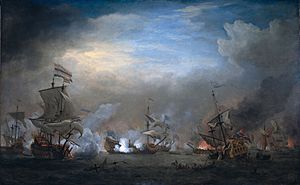
The Allies continued to hold their position off the Dutch coast. On June 14, De Ruyter used favorable winds and launched the Second Battle of the Schooneveld. Again, this caused chaos in the unprepared Allied fleet. They suffered severe damage and returned to the Thames river for repairs. In late July, Prince Rupert sailed again, hoping to draw the Dutch north by pretending to attack two Dutch cities. Although De Ruyter preferred to stay where he was, he was ordered out to escort a valuable incoming Dutch trading fleet. Both sides suffered severe damage in the resulting Battle of Texel. Prince Rupert was forced to return home for repairs.
The behavior of the French led to many complaints and accusations that they had not supported their English allies. Whether this was fair is still debated. In all three battles, De Ruyter took advantage of Allied weaknesses in fighting instructions and signaling. Regardless, it deepened suspicions between the English and French. This further reduced public support for the war. It also ended any hopes of starving the Dutch through a naval blockade. The result was a huge strategic victory for the Dutch, even though four ships of their Spice Fleet had been captured by the Allies. For De Ruyter, the successful campaign, by stopping attacks from much stronger fleets to save his homeland, was the highlight of his career. The English readily admitted his skill. The Duke of York concluded that among admirals, "he was the greatest that ever to that time was in the world." The English had to give up their plans for an invasion from the sea, and the high repair costs worried Parliament.
Growing Opposition to the War in England

In earlier conflicts, investing in privateers (private ships allowed to attack enemy shipping) had been very profitable for the English. But from 1672 to 1673, Dutch raiders captured over 2,800 French and English ships, far more than their enemies captured. The Dutch province of Zeeland alone had 120 privateers. Having failed to block the Dutch coast, English merchants were shut out of the important trade in shipbuilding materials from the Baltic Sea. The loss of New Amsterdam and Dutch attacks on English lands in India caused further damage to their trade. These financial losses added to a moral unease about whether the war was fair. After Solebay, a writer named John Evelyn wrote that the loss of a key English leader made him feel even worse. He also questioned the wisdom of risking such a good fleet and losing so many men, "for no provocation in the world but because the Hollander exceeded us in industry, and all things else but envy."
This increased English disappointment with the war. At the same time, the Dutch military's improved position helped their finances. This allowed the Dutch government to increase its military budget. Louis XIV had attacked the Dutch Republic hoping for a quick victory. Once this failed, he faced a long war on many fronts. In July 1673, French troops captured Maastricht. On August 30, the Dutch agreed to an alliance with the Holy Roman Emperor and Spain. In October, they were joined by the Duke of Lorraine, whose land was occupied by France. This formed the Quadruple Alliance.
William of Orange made sure the peace talks held in Cologne with France and England failed. In September, he recaptured a city. Münster and Cologne made peace, and French troops left the Dutch Republic, keeping only two cities. With a French victory over the Dutch now unlikely, the war became about control of Flanders. This issue divided England and France. This was an important reason for English opposition to the French alliance. But events within England were even more important.
In early 1673, a former secretary fled to the Dutch Republic. There, he started a propaganda campaign, helped by the Dutch's large printing capacity. England was soon flooded with thousands of pamphlets. These accused Charles II of secretly working with Louis XIV to make England Catholic again. Many people believed this, especially when Charles allowed his brother and heir, James, to marry Mary of Modena, a very religious Catholic. In February 1673, Parliament refused to approve more taxes unless Charles withdrew his proposed Indulgence and accepted a law that banned Catholics from public office. In June 1673, James resigned as head of the navy. This was seen as proof of rumors that he had secretly become Catholic and could not follow the new law. Since Charles had no legitimate children, James's marriage now meant there was a strong chance of a Catholic royal family ruling England in the future.
A key English minister, who had learned about the secret parts of the Treaty of Dover the previous year, reacted to the changed public mood by telling other politicians. As a result, the King's advisors joined those who wanted peace with the Dutch. Shocked by the revelation of Charles's agreement with Louis, another important leader began to consider removing the royal family entirely. With his support, a famous philosopher developed legal ideas that appeared in his work, which criticized absolute monarchy.
The Second Peace of Westminster
In this situation, Charles II felt that continuing the alliance was a serious threat to his own position. He also knew that Parliament would no longer fund the war. He told the French ambassador that, with regret, he had to end England's war effort. He told the Dutch, through the Spanish consul in London, that his main war goal—to make his nephew William the leader—had been achieved. He no longer objected to making a lasting peace between the two Protestant nations, if only some small payments could be made. At first, the Dutch province of Holland did not want to grant Charles's demands. In their opinion, England had achieved nothing in the war, so it deserved no reward. But William convinced them that there was a chance of getting Charles to join the war against France later. Also, Spain had not yet declared war on France and was only willing to do so if England made peace, because it feared English attacks on its American colonies.
After a quick exchange of proposals, the Treaty of Westminster was publicly announced in London on February 17. It was approved by the Dutch province of Holland on March 4, and by the main Dutch government on March 5.
The treaty stated that New York (formerly New Netherland) would now be an English possession. Suriname, captured by the Dutch in 1667, would remain their colony. This confirmed the situation from 1667. The Dutch were to pay England two million guilders as a "payment." Eventually, William would force Charles to use these payments to settle debts Charles owed to William's family. So, the English king actually received very little money.
Despite the peace, English soldiers serving in the French army were not withdrawn. They were allowed to recruit more soldiers in Britain until the end of the Franco-Dutch War. In April that year, William tried to convince his uncle Charles to join the war against Louis, but he failed. Until the end of the war in 1678, Charles tried to negotiate between the two sides. At times, he pretended to consider a conflict with France when it benefited him. In 1677, he forced his niece Mary to marry William. This marriage would later play a big role in the fall of his brother James in 1688.
Images for kids
-
Charles II of England wanted French money to be free from Parliament's control.
-
The 1667 Raid on the Medway greatly damaged King Charles's reputation.
-
Lieutenant-Admiral Michiel de Ruyter's training made up for fewer ships.
-
Gaspar Fagel, a supporter of William of Orange, became the new Grand Pensionary in August 1672.
-
The recapture of Coevorden on December 30, 1672, greatly boosted Dutch morale.
-
Sir Edward Spragge, killed at the Battle of Texel.
-
The Battle of Texel (1707) by Willem van de Velde the Younger.
-
Anthony Ashley Cooper, a leader against the war.
-
Mary of Modena; her marriage to James increased opposition to the war.


